Chad Hartman – Let’s start the journey in 1986. You both find out you’re turning pro for Kryptonics. What was going on with your life at the time?
Art Godoy – In 1986, we were just done with Zorlac. We had been riding for them since 1983 when we moved to Texas from Mexico City, where we lived with our dad for the last two years of high school.
We placed high in a Dallas amateur contest. I got first, and Steve got fourth. I got sponsored by Zorlac and Steve by Powell. Zorlac was a small company then, a one-person show – Jeff Newton. They had a few riders, and Jeff Phillips rode for them then.
So there wasn’t room for both me and Steve for their budget. Steve eventually was off Powell and got on Zorlac… Only a logical decision.

Art Godoy And Steve Godoy
Steve Godoy – To clarify, we didn’t really “find out” we were turning pro. We just decided to. The East coast skate scene was very limiting, mainly because of the seasons. At our age, and because we couldn’t drive, our progression was limited. But after some hard work – as sponsored amateurs for a bit, we decided it was time to move on to bigger things.
We lived in Lancaster, Pennsylvania, from age eight till early high school and started skating in late 78 or so. At one point-high in school, we moved to Mexico City, then to Dallas, Texas, where we skated daily with Craig Johnson, Jeff Phillips, and Dan Wilkes… We were getting good real quick… How could we not? We had never seen skating done the way these guys did it.
There was a huge noticeable difference in our progression. We moved back to PA for a bit and went pro at Virginia Beach, Mount Trashmore Ramp, in 1985. Then we moved back to Dallas. And as Art said, Zorlac was a dead end. So we opted for what we thought was a logical choice – the Kryptonics, Godoy twin pro model.
Our decision was a sort of go back to our east coast skate roots with an East coast company with massive distribution and full-color advertising in magazines… We talked with Dorsey Truitt, Who was making all the Kryptonics High energy decks at the time. He was agreeable to making the Godoy deck. Their artist Kim Hardt did those graphics and sure did a rad job on them…Real clean!
Art – A few years later, we planned to turn pro for them and had a few discussions with Jeff Newton. We had a shape and graphics ready to go. Nothing ever materialized. We planned to share a model board, which would have been a first. It was the first time twins shared a pro model ever.
Months passed… Production of the Godoy Zorlac deck was postponed due to a “wood shortage.” That is what we were told… And then some other excuses soon. We were getting information about things they allegedly did that rubbed us the wrong way, so we decided to move on.
At the time of the Kryptonics, two-headed graphics – We were done with Zorlac, living outside, breaking into an abandoned country bar to sleep at night, sometimes under or on top of the blue clown ramp, or in our car, still skating every day.
We had a friend named Sad Dave who occasionally lived outside too. He was artistic and had a cool style of art. He drew up an idea. It was based on a description we let out in a casual conversation of a two-headed character attached to a spiked wrist band, a fist, and a finger pointing to Texas where we’re at.

Godoy Twins Deck
[Editor Update – You can now get the Godoy Twins Deck 10″ x 30″ HERE] Limited only 50 made, grab one fast before sold out!
We had shapes, which we sent in, but since they didn’t produce custom shapes at the time, they gave us a pig shape. That shape was not our choice, but this is how they did their production: same shapes, different graphics. We had no problem riding it. If it brought us a paycheck, so be it.
Steve – We were hoping that in a short time, they would change the format and start custom shape production but that didn’t happen until a couple years later Their decks were not on par with the latest concaves, shapes, and reputations that other board companies had at the time.
We were homeless, eating out of dumpsters, panhandling, and selling gear. No jobs. We are now and always have been ‘straight edge.’ No drugs, no drink, no smoke. So we didn’t have habits to support except for skating, tattoos, punk music, and chicks. Being homeless, it was easier to focus on skating, especially since we lived in the car, on the ramp, or in abandoned buildings surrounding the Bachman Lake Skate ramp area.
Art – Do you remember the “no bullshit boards” ad? We were embarrassed to say that it was a no-bullshit board. But we had to get some sales… Kinda saying that the weird custom shapes of the era were gay, but in reality, we had a badass stinger shape sitting at Atlantic Skates waiting to see the fucking sun.
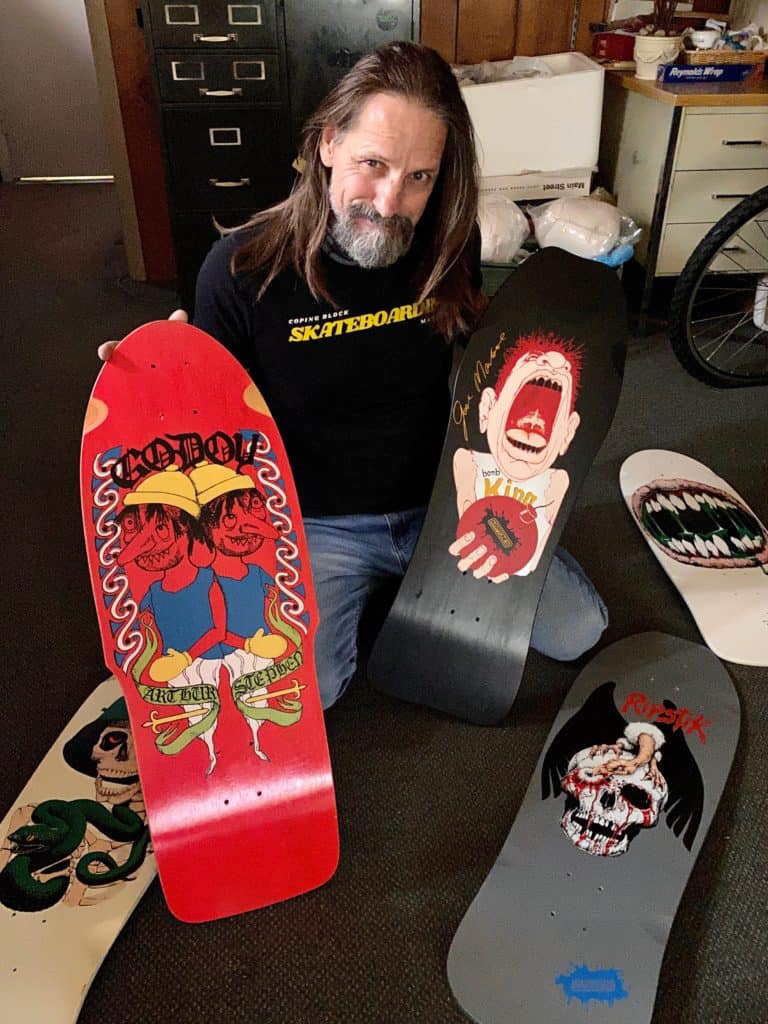
Patrick Truitt holding the “Pinnochio deck”
Those graphics would have been RAD on the stinger shape. We had no control over that deck. That photo shoot for that ad was done at a Houston SUAS contest. We were living in the car, and we drove there from Dallas, still homeless, but you’ll notice that we still had expensive creepers on, real Robot brand creepers, and still fucking millionaire’s daughters…
In the other Atlantic photo shoot, where we were doing doubles riding Phillips shaped Two-headed model – It was a cold winter morning in Dallas… Grant Brittain came out on a flight paid for by Tracker and Atlantic to shoot the ad. We were supposed to be paid to wear those fruity board shorts and those cheap shit Haro knee pads but never got any money for it. Those shorts weren’t ‘us’, not our style, but oh well.
That deck was the last of the Kryptonics Pro Model production decks, after the Micke Alba and Steve Alba decks. Even though licensed by Atlantic Skates, it was still known as and produced under the name Kryptonics, a brand which we were proud to ride. ‘
Even though it wasn’t REALLY Kryptonics, it had the name. Originally, Kryptonics was a Colorado company, all decks and wheels made in-house. They were the first wheels we ever rode on our first 8″ Sims Lonnie Toft decks, Star-Trac Kryptonics, blue ones, and green ones.
Steve – We are hoping for a release date soon. Pat says October 15th at the west coast Skatercon event, where we will play music under the name The Fuckin’ Godoys. The east coast had their skate groups like the Boston guys, Public Menace, or MFC –Rob Mertz, etc… We were just the Godoy’s trying to get a good board sponsor that we could be stoked on, that would be stoked on us… High Energy was not a name we even knew or heard of…So we still don’t know what brand he will use for our deck.
The Pinnochio Deck
Your next model with Kryptonics was the Pinocchio deck, correct?
Art – The Pinnochio Deck was drawn in an apartment we moved into after being outside. We were living with our friend Charlie Bowman, he ruled. We drew these up… With our full names on the deck! I don’t know how serious we were about the deck we had already considered quitting Kryptonics. We didn’t have total faith in Kryptonics. If you didn’t have a deck with your own shape or graphics, you weren’t projecting who you were or the image you wanted to portray.
When we’d show up at events, nobody had any idea how broke we were. We were riding for Tracker Trucks at the time. We told Larry Balma what was going on, and we were hoping that he could help. He had talks with Kryptonics, telling him that pros get custom shapes and custom graphics, and to invest in that, and produce that… As well as trips to contests, demos, etc. We were hoping things would turn around and that Kryptonics would realize and comply.
There was no substance behind the Pinocchio deck. It was a too little, too late effort. We just wanted to throw it out there and see what would happen. The characters were called “anus eaters,” hahaha!
They were a series of comic people we made up. They had sharp teeth which could come out as a spiral drill bit, like a drill saw blade, and drill out chick’s asses so they could eat them after they ate the pussies. Anus eaters didn’t wanna damage the pussy, just the anus.
So I’m assuming the run was short-lived, and not many were produced?
We don’t know if it was a short-lived deck. Because we quit right after that. We had no idea how short or long these ran for. We had seen several colors on shelves, but the color print was all the same,
Steve – That deck was not exactly a ‘thought out’ graphic. It was filler, a time killer… We didn’t put any credence in it and were trying to figure out our next move. We even had Tracker’s Larry Balma send us blanks that we silk-screened some graphics on… We were in limbo, with no pay.

So I’m assuming moving over to Skull Skates was an easy decision.
Steve – We moved on to Skull Skates without hesitation, leaving the hopelessness of Atlantic Skates behind. The Skull Skates image in skateboarding was seemingly rebellious and anti-competition… More suited for raw skating, and NOT the typical, fashionable – “how someone placed in a contest” criteria, like all the “big named” industry exploiting moguls like Vision, Powell, G&S, and Sims.
So what inspired the Skull Skates Gargoyle model?
Steve – Skull Skates sold boards, simple two-color or one-color graphics. Our Gargoyles suited the custom shape of our pro model deck. We were finally happy when that deck was released. Still, to this day, it is one of our all-time favorite pro models. The graphics were not polished. They were scratchy… Intentionally, rough…
Art – The Skull graphics were inspired by the Damned Black Album. We had been tattooing since 1985 already, and tattoos didn’t have any influence on this artwork. It was mostly because we had been listening to the album a lot during that time. Skull Skates had a 1-2 color standard print style on their decks, mostly white on black. The decks were great. They had their own wood and could produce as much or as little as they wanted…
Steve, you end up skating for Circle A. How did that come about?
Steve – Bob Schmeltzer was in charge of Circle A. He was funded by a guy named Bernie Tostenson, who did Ugly Stix and founded Brand-X in Gardena… Bob was into punk and knew of us and our reputation. We made a deal.
Did you do those graphics?
Steve – I did not do those graphics. He had an in-house artist named Kevin Marburg. Marburg made all the decks look uniform. Really great style. I gave him the ideas, and he ran with them. I loved that deck. That company could have gone somewhere.
Around this time Art gets a pro model with H-Street. On a personal note, this is the deck that got me into skateboarding. How did you go about creating the graphic?
Art – I had left Texas and went to California. I heard Tony Magnusson was forming a team for his new company H-Street. I had some gnarly ideas for graphics, but he said that since the decks were being bought by mothers of 14-year-old kids, the ideas would not be great sellers.
Even within the constraints, it seems like Radio Birdman and The masculine Samurai were personal to you. The art had such a great contrast of images and colors.
Art – This was sort of a cartoony version of a Japanese-inspired piece of art. What was gnarly about these graphics and all the other ones we did for H-Street was the color separations. All of it was done by hand, cutting ruby, using rub-off shading film on acetate, using black rapidograph ink pens to thicken lines, etc.
I have this board on my wall, and the art looks complex.
Art – Though simple-looking, these were complex to print. The Art Godoy samurai had like twelve screens to produce. The Radio Birdman logo was important. That’s our favorite band. And part of our life’s soundtrack, especially then.
You had three other models with H-Street. What inspired The Fish, The Demon, The Sea Serpent, and The Turtle?
Art – The mini deck with the demon and the sea serpent has no real story. Those were just sketches and ideas. The original images were edgy, then made more kiddy to sell to these mothers. The Fish deck was rad. It wasn’t as busy as The Samurai, but effective. The idea for the lettering was from a Barracudas album called “Drop Out with The Barracudas.” It was rad. That one was great.
When that one came out, changes were happening with the wood sources H-Street was using. The best Hell concave decks were by Dave Bedore, who used to make uncle wiggly. He ripped too. He was a Del Mar local. These were 6-ply fiberglass decks before they used A and M and Taylor versions of the hell concave.
The Fish and The Turtle were Fuckin thin and perfect, they were in the same series. Great concave. These were the best ones made visually and functionally. The A and M decks sometimes had problems with delimitation.
While at H-Street, you did graphics for several other pros as well. How involved were you with the process?
Art – We were mostly involved in every part of the creative process, from idea to sketch, to the black line, and then to hand-cut color separations and films. We usually didn’t know what the graphics would look like when finally printed on the decks. We used so many dot patterns and matrixes, which were meant to overlap each other, creating colors in different combinations and blends that we could predict… But we had no idea what they would look like until final production was done.
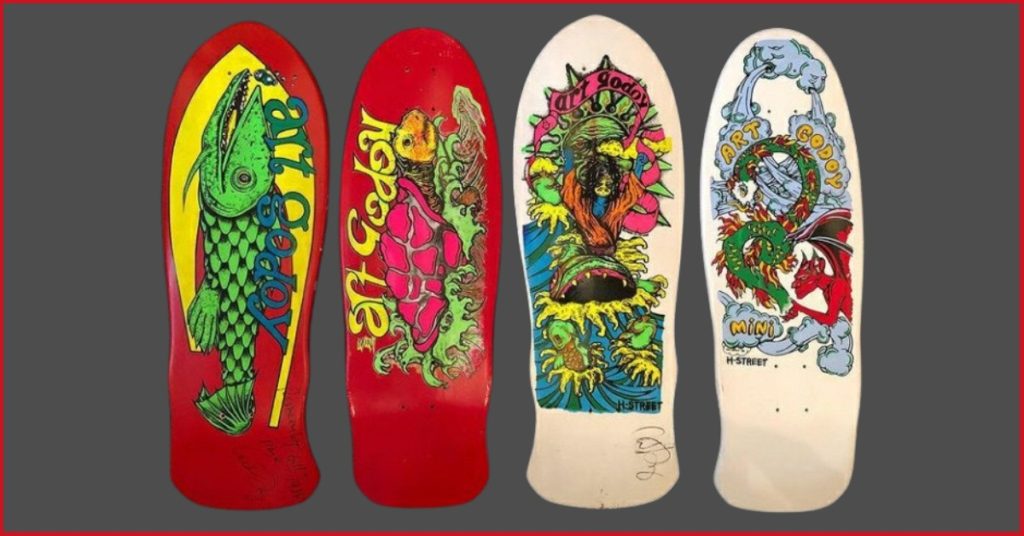
These are still some of the best graphics in history.
Art – We knew they were going to be rad. We did not do the screening for H-Street. They had their own warehouse, which handled shipping and silk screening. Other pros who rode for the company wanted us to do their graphics. Eddie Elguera, John Shultes, Tony Magnusson, Danny Way, and Ron Allen were the main graphics we did for H-Street. It was cool to do these graphics for the boards because each board and rider had a matching T-shirt. So we got to be creative in other avenues besides skateboard deck graphics.
And that led to other work?
Art – At the time, we had done graphics for other companies such as Quiksilver, O’Neill, Pirate Surf, Killer Bees Wax, No Fear, Neal Morgan surf designs, etc. Some clients had their ideas, and others just looked at the graphics and decided they liked them. That happened with Tony Magnuson’s Wild Pigs and the Eddie Elguera Scarecrow Decks. John Schultes had some ideas of his own, and we used to work with him on his ideas to bring them to life.
Steve – We watched H-Street grow quickly. The graphics we drew for their boards looked so rad. Their concave was state-of-the-art. We were using our artistic talent to shape someone else’s dream. Maybe that’s why we still had still an incomplete feeling inside. On the one hand, we were stoked to make some money, tattooing on the side, getting some royalty checks for board sales, and some money for doing graphics as opposed to being scroungy and homeless, like a couple of years prior. Now we were still scroungy but needed something to set us up financially. And we needed to stop feeding someone else’s dreams.
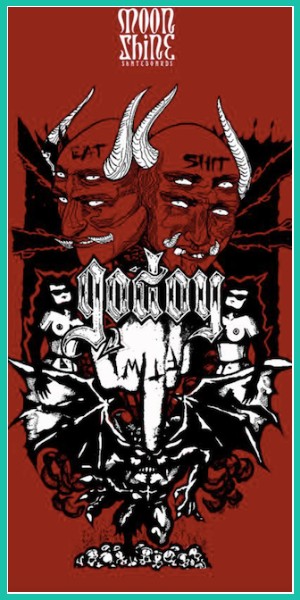
In 1990 you two started Iron Cross Skateboards. In a short time, you guys put together a killer team, worked on graphics, and learned the ropes of small business. What happened?
Art – Nobody knows the inside story about Iron Cross unless they were involved. The iron cross was gnarly. We treated our amateurs like pros. They were going to all the contests. They could not want for more. They had shoes when they needed them. They had trucks, wheels, decks, shirts, and clothing from other companies, which would cosponsor our riders. They even got tattooed when we had time.
Steve – Iron Cross was a dream come true. Fuckin fast global expansion, gnarly graphics with 80s colors… Behind it was fuckin’ rawness.
Art – It became more of an organization over time rather than just a skateboard company. We could’ve done things differently and should have. We had the savings to separate us from H-Street as our backer. We had accounts and potential projects opening up South of the border. We are and were always a big deal in Spanish-speaking countries, from Mexico, to further south, and our reputation continued so in the world of tattooing and punk.
Steve – Everything that looked to outsiders to be glorious, for us was not. We never had shit handed to us.
Art – We should have taken our savings and invested right back into expansion. Instead, we rode the H-Street wave till the end, when we learned that they could not be trusted, and it was too late. Like scenarios in every company we had skated for in our career, the accounting was never proven to be correct.
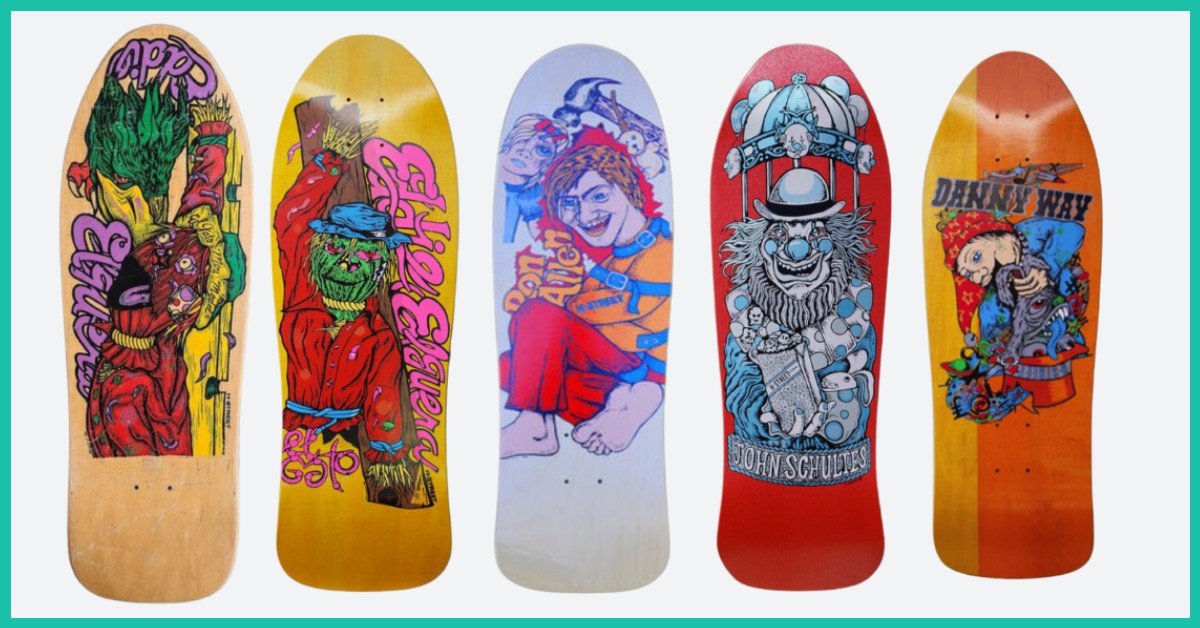
We were collecting royalties for the sale of decks. In other words, they paid for production and advertising. We handled sales and team management. We had no say (or contacts) in manufacturing. H-Street sold our remaining stock for $20 per deck for completes.
Their original backer was a company who produced toy skateboards. These were like the toy Sure Grip decks, the toy Variflex decks – Total Kmart complete decks with trucks that don’t turn. Cheap wheels and shitty bearings. The decks that we had were stored in this toy warehouse.
Art – They were in talks with a rider (whom we shall not name) who was slandering our company to suppliers and skate shops. We got wind of this, and let’s just say he’s lucky to be walking. People involved with I.C.S. at the time were gnarly. These were people to not fuck with.
Steve – That’s the way we do life. We create our reality based on authenticity. We don’t pretend to be something we are not and remain elusive to those that don’t know us.
Art – We saw that things were changing too much and that vertical skateboarding was starting to become obsolete as the street skaters took over. The small wheels, the big baggy pants, tiny popsicle decks… And if you could not adapt to this, you would never survive unless you had savings. We ended up saying goodbye to the skate business.
You have played a significant role in skateboarding, tattooing, and music. You have created some of the most iconic skateboard graphics, done some stylish frontside airs, and have been true to yourselves all these years. You have inspired more souls around the world than you can imagine!
Steve – Our skate art is a tiny, teeny, piddly part of our lives… If it did leave a mark, then even better. We never did shit for overt recognition, but we believe when credit is due – it needs to be paid. We married skateboarding and tattooing. It was a by-product that came from what we did every day… Not modeled after anyone.
Steve – Thanks for the words. Sometimes we don’t see the grandness until reflecting on the past and what materialized from it…because we are always so busy doing just what makes us tick, without ego or selfish intentions… Without searching for recognition like most of these fame seekers. Simplicity. Just being ourselves, not sell-outs, not commies, not gonna lick ass for a buck…we are now and always have been approachable yet private…could be a little misunderstood. FTW!!! The Fuckin’ Godoys
Check out the Art and Steve Godoy Blog and follow godoytattoos on Instagram.

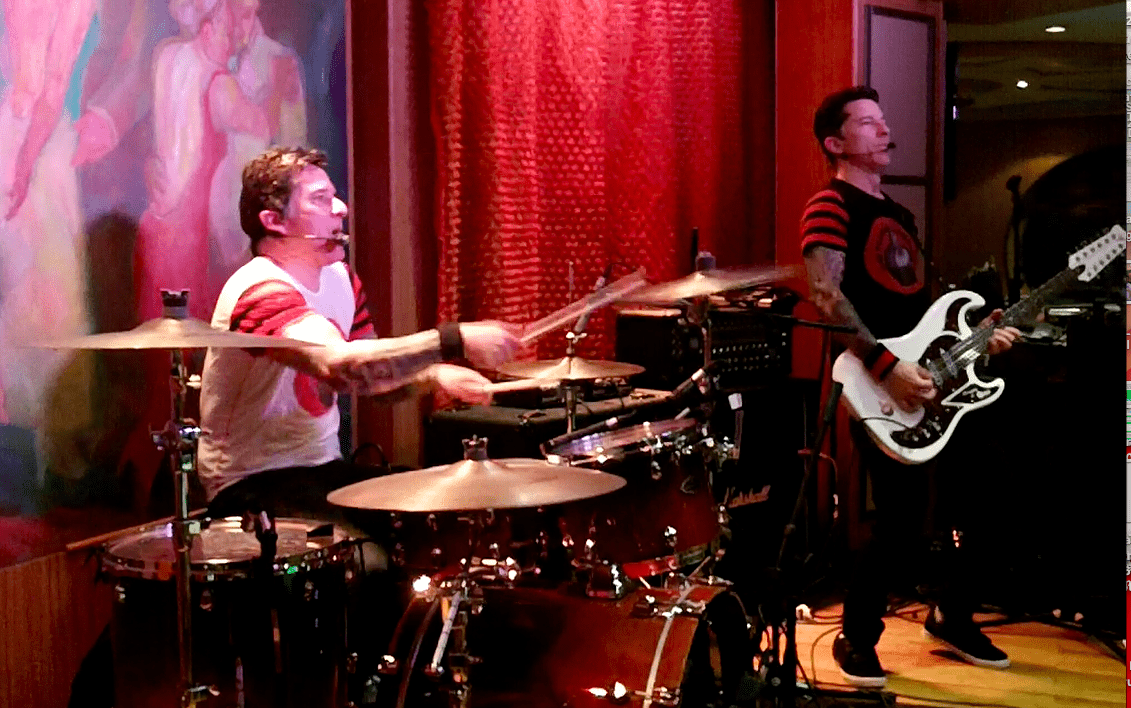
Beautiful history from the guys who wrote a great chapter in the big book of skate history.
Great article Fatz!!
Really appreciate the comment Dave! Thanks a million…